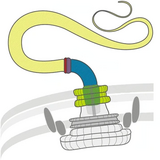Gliding motility
Gliding motility is a type of translocation used by
Twitching motility also allows microorganisms to travel along a surface, but this type of movement is jerky and uses pili as its means of transport. Bacterial gliding is a type of gliding motility that can also use pili for propulsion.
The speed of gliding varies between organisms, and the reversal of direction is seemingly regulated by some sort of internal clock.
Cell-invasion and gliding motility have TRAP (thrombospondin-related anonymous protein), a surface protein, as a common molecular basis that is both essential for infection and locomotion of the invasive apicomplexan parasite.[5] Micronemes are secretory organelles on the apical surface of the apicomplexans used for gliding motility.
In the diagram above, right:
| a) | type IV pili
|
| A cell attaches its pili to a surface or object in the direction it is traveling. The proteins in the pili are then broken down to shrink the pili pulling the cell closer to the surface or object that was it was attached to.[6] | |
| b) | Specific motility membrane proteins |
| Transmembrane proteins are attached to the host surface. This adhesion complex can either be specific to a certain type of surface like a certain cell type or generic for any solid surface. Motor proteins attached to an inner membrane force the movement of the internal cell structures in relation to the transmembrane proteins creating net movement.[7] This is driven by the proton motive force.[8] The proteins involved differ between species. An example of a bacterium that uses this mechanism would be Flavobacterium. This mechanism is still being studied and is not well understood.[9] | |
| c) | Polysaccharide jet |
| The cell releases a 'jet' of polysaccharide material behind it propelling it forward. This polysaccharide material is left behind.[10] |
Types of motility
| Part of a series on |
| Microbial and microbot movement |
|---|
 |
| Microswimmers |
| Molecular motors |
Bacterial gliding is a process of motility whereby a
Bacteria move in response to varying climates, water content, presence of other organisms, and firmness of surfaces or media. Gliding has been observed in a wide variety of phyla, and though the mechanisms may vary between bacteria, it is currently understood that it takes place in environments with common characteristics, such as firmness and low-water, which enables the bacterium to still have motility in its surroundings. Such environments with low-water content include biofilms, soil or soil crumbs in tilth, and microbial mats.[11]
Purpose
Gliding, as a form of motility, appears to allow for interactions between bacteria, pathogenesis, and increased social behaviours. It may play an important role in biofilm formation, bacterial virulence, and chemosensing.[13]
Swarming motility
Swarming motility occurs on softer semi-solid and solid surfaces (which usually involves movement of a bacterial population in a coordinated fashion via quorum sensing, using flagella to propel them), or twitching motility[12] on solid surfaces (which involves extension and retraction of type IV pili to drag the bacterium forward).[14]
Proposed mechanisms
The mechanism of gliding might differ between species. Examples of such mechanisms include:
- microfilaments causes a mechanical force which travels to the adhesion complexes on the substrate to move the cell forward.[15] Motor and regulatory proteins that convert intracellular motion into mechanical forces like traction force have been discovered to be a conserved class of intracellular motors in bacteria that have been adapted to produce cell motility.[15]
- A-motility (adventurous motility)[11][13][16] as a proposed type of gliding motility, involving transient adhesion complexes fixed to the substrate while the organism moves forward.[13] For example, in Myxococcus xanthus,[11][12][13][17] a social bacterium.
- Ejection or secretion of a polysaccharide slime from nozzles at either end of the cell body.[18]
- Energized nano-machinery or large macromolecular assemblies located on the bacterium's cell body.[15]
- "Focal adhesion complexes" and "treadmilling" of surface adhesins distributed along the cell body.[13][2]
- The gliding motility of Flavobacterium johnsoniae uses a helical track superficially similar to M. xanthus, but via a different mechanism. Here the adhesin SprB is propelled along the cell surface (spiraling from pole to pole), pulling the bacterium along 25 times faster than M. xanthus.[19] Flavobacterium johnsoniae move via a screw-like mechanism and are powered by a proton motive force.[20]
See also
References
- ^ PMID 28222296.
- ^ PMID 24556443.
- PMID 9427622.
- PMID 20580218.
- PMID 9267031.
- PMID 7903032.
- PMID 11544349.
- PMID 9421895.
- PMID 16199564.
- PMID 9799733.
- ^ PMID 10477310.
- ^ PMID 11544349.
- ^ PMID 17289998.
- PMID 27028358.
- ^ PMID 21482768.
- PMID 17704221.
- PMID 21931562.
- ^ Merali, Zeeya (3 April 2006). "Bacteria use slime jets to get around". New Scientist. Retrieved 17 January 2010.
- PMID 24556443.
- PMID 27602728.
